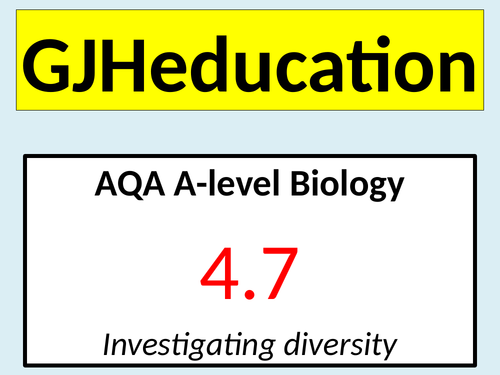




This lesson describes how genetic diversity within, or between species, can be investigated by comparison of characteristics or biological molecules. The PowerPoint and accompanying worksheets are primarily designed to cover the content of point 4.7 of the AQA A-level Biology specification but as this is the last lesson in the topic, it has also been planned to contain a range of questions, tasks and quiz rounds that will challenge the students on their knowledge and understanding of topic 4.
Over the course of the lesson, the students will discover that comparisons of measurable or observable characteristics, DNA and mRNA sequences and the primary structure of common proteins can all be used to investigate diversity. Links are continually made to prior learning, such as the existence of convergent evolution as evidence of the need to compare biological molecules as opposed to the simple comparison of phenotypes. The issues associated with a limited genetic diversity are discussed and the interesting biological example of the congenital dysfunctions consistently found in the Sumatran tigers in captivity in Australia and New Zealand is used to demonstrate the problems of a small gene pool. Moving forwards, the study of the 16S ribosomal RNA gene by Carl Woese is introduced and students will learn that this led to the adoption of the three-domain system in 1990. The final part of the lesson describes how the primary structure of proteins like cytochrome c that is involved in respiration and is therefore found in most living organisms can be compared and challenges the students to demonstrate their understanding of protein synthesis when considering the differences between humans and rhesus monkeys.
Get this resource as part of a bundle and save up to 39%
A bundle is a package of resources grouped together to teach a particular topic, or a series of lessons, in one place.
Topic 4: Genetic information, variation and relationships between organisms (AQA A-level Biology)
Every one of the lessons included in this bundle is detailed, engaging and fully-resourced, and has been written to cover the content as detailed in topic 4 of the AQA A-level Biology specification. The wide range of activities will maintain engagement whilst supporting the explanations of the content to allow the students to build a deep understanding of genetic information, variation and relationships between organisms. The following 17 lessons covering the 7 sub-topics are included in this bundle: 4.1: DNA, genes and chromosomes * DNA in prokaryotes and eukaryotes * Genes 4.2: DNA and protein synthesis * Genome, proteome and the structure of RNA * Transcription and splicing * Translation 4.3: Genetic diversity can arise as a result of mutation or during meiosis * The genetic code * Gene mutations * Chromosome mutations * Meiosis 4.4: Genetic diversity and adaptation * Genetic diversity * Natural selection * Adaptations 4.5: Species and taxonomy * Species and taxonomy 4.6: Biodiversity within a community * Biodiversity within a community * Calculating an index of diversity * The balance between conservation and farming 4.7: Investigating diversity * Investigating diversity * Interpreting mean values and the standard deviation If you would like to sample the quality of the lessons in this bundle, then download the DNA in prokaryotes and eukaryotes, structure of RNA, gene mutations, natural selection and standard deviation lessons as these have been uploaded for free
Topics 4.4 - 4.7 (AQA A-level Biology)
These 7 lessons are highly detailed and are filled with a wide range of tasks that will engage the students whilst covering the following specification points in topics 4.4, 4.5, 4.6 and 4.7 of the AQA A-level Biology specification: 4.4 Genetic diversity as the number of different alleles of genes in a population and a factor enabling natural selection to occur The principles of natural selection in the evolution of populations Directional and stabilising selection Natural selection results in anatomical, physiological or behavioural adaptations 4.5 Two organisms belong to the same species if they are able to produce fertile offspring The taxonomic hierarchy comprising domain, kingdom, phylum, class, order, family, genus and species The use of the binomial name to identify species 4.6 Biodiversity can relate to a range of habitats Species richness Calculating an index of diversity 4.7 Investigating genetic diversity with, or between species, by comparing observable characteristics or nucleic acids and the structure of proteins Calculating and interpreting the mean and standard deviation If you download the natural selection and standard deviation lessons which have been shared for free then you will be able to see the quality of lessons included in this bundle
Something went wrong, please try again later.
Lovely resource. Great activities for the sixth formers.
Report this resourceto let us know if it violates our terms and conditions.
Our customer service team will review your report and will be in touch.